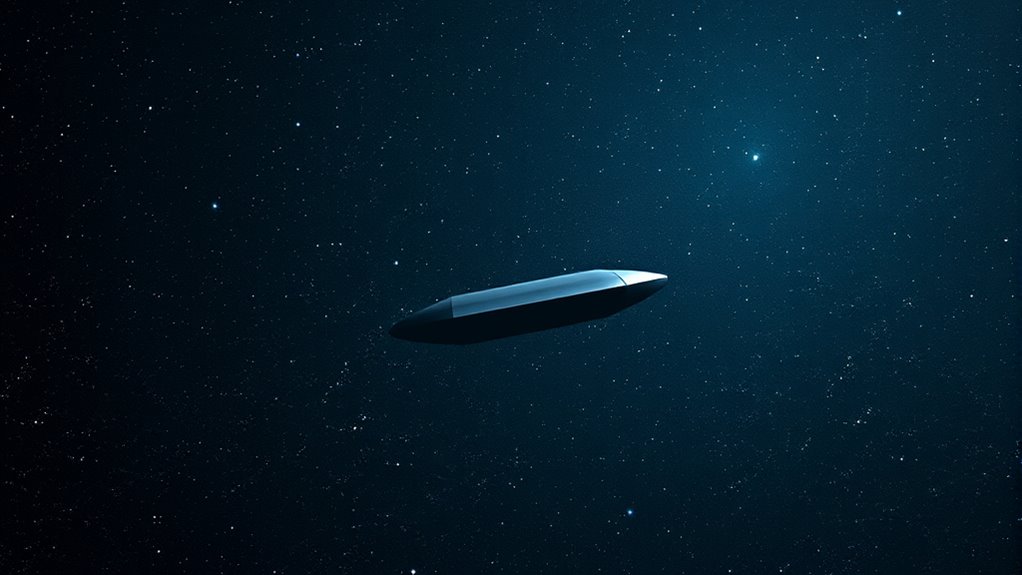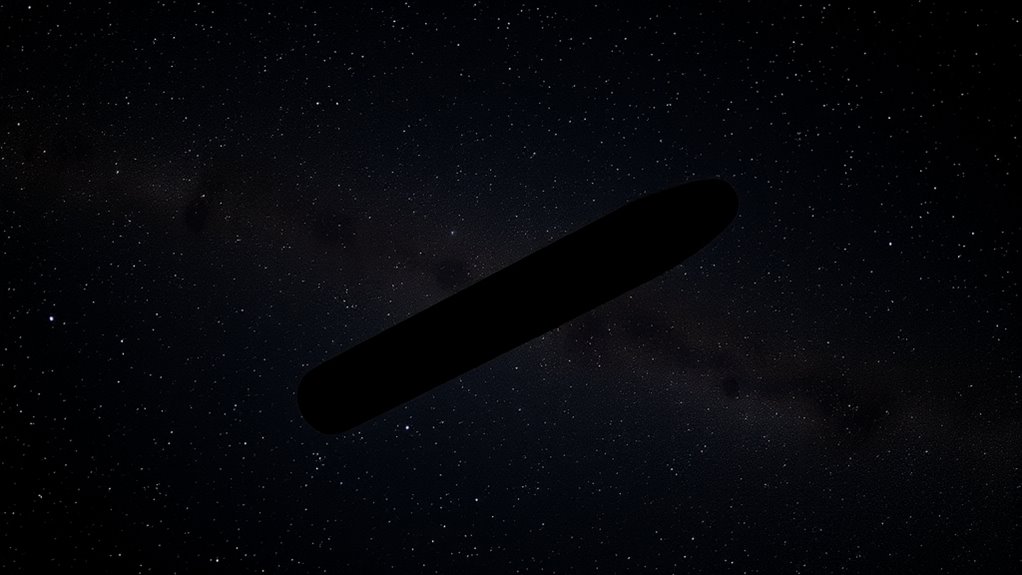A new theory suggests that ‘Oumuamua might be an artificial object or alien probe, challenging the idea that it’s just a natural interstellar body. Researchers point to its unexpected acceleration and shape as clues it could be a manufactured artifact from an advanced civilization. If true, it could mean interstellar travel involves specialized objects like this. To uncover more fascinating insights and what this could mean for future space exploration, keep exploring this compelling topic.
Key Takeaways
- Recent research suggests ‘Oumuamua may be an artificial object or alien probe rather than a natural space rock.
- Its unexpected acceleration and lack of outgassing support the hypothesis of an engineered origin.
- Theories propose ‘Oumuamua could be a manufactured artifact from an advanced civilization.
- If artificial, it indicates interstellar objects might be remnants or probes from extraterrestrial civilizations.
- Future studies aim to identify signs of artificiality and better understand interstellar travel implications.

Have scientists made new discoveries about ‘Oumuamua that could change our understanding of this mysterious object? Recent research suggests they might have. ‘Oumuamua, the first known interstellar object to pass through our solar system, has puzzled astronomers since its discovery. Its unusual shape, unexpected acceleration, and mysterious origins have fueled debates about whether it’s a comet, asteroid, or something entirely different. Now, new theories are emerging that could reshape how we interpret this visitor from another star system, especially concerning interstellar travel and comet origins.
Traditionally, scientists considered ‘Oumuamua as a type of comet or asteroid ejected from its home star system. But its lack of a visible coma—an atmospheric cloud typically seen around comets when they get close to the Sun—raised questions. Some researchers think it might be a fragment of a larger body or a product of unusual formation processes. However, recent studies propose a more radical idea: ‘Oumuamua could be a piece of alien technology, a probe or artifact left behind by an advanced civilization. This hypothesis stems from its peculiar acceleration without any visible signs of outgassing, which is common in comets. If true, it would suggest that interstellar travel might be more feasible than we previously believed, potentially involving specialized objects designed for long-distance journeys.
This new perspective shifts the focus from ‘Oumuamua being just a natural object to considering it as an artifact of interstellar travel. If it’s a manufactured object, it might have originated from a planet or civilization that developed advanced propulsion methods. Such a discovery would revolutionize our understanding of comet origins, indicating that not all interstellar visitors are natural bodies. Instead, some could be remnants or probes from distant worlds, carrying information or technology across the cosmos. This idea opens the door for future research to look for signs of artificiality and to rethink how objects traveling between stars might appear. Artificial objects could be more common than previously thought, prompting scientists to develop new methods for detection and analysis. Additionally, understanding the physical properties of these objects could help us identify other potential interstellar artifacts.
Scientists are now exploring how ‘Oumuamua’s properties fit into a broader context of interstellar travel and migration. They’re examining if it could be a fragment of a spacecraft or a piece of debris from some ancient, long-lost civilization. Some researchers also suggest that interstellar objects might serve as natural or artificial carriers of information across the galaxy. If confirmed, this would imply that interstellar travel is not only possible but has been happening for much longer than we thought. The implications extend beyond understanding ‘Oumuamua itself; they challenge our assumptions about the origins of interstellar objects and what they can tell us about the universe’s technological capabilities. Additionally, researchers are considering whether astrological influences or cultural beliefs could have an indirect role in shaping human perceptions of such mysterious objects. Emerging studies on interstellar object detection further support the idea that such objects could be more than just natural phenomena. As new data and observations come in, researchers remain hopeful that we’ll uncover more clues, possibly turning ‘Oumuamua into a doorway to understanding interstellar travel and the true nature of comet origins.
Frequently Asked Questions
Could Oumuamua Be an Alien Spacecraft?
You might wonder if Oumuamua is an alien spacecraft, but current evidence leans toward natural origins. Still, some scientists consider the extraterrestrial hypothesis, suggesting it could be alien technology. While intriguing, there’s no definitive proof it’s an alien craft. Instead, researchers explore natural explanations, like a fragment from a disrupted comet or asteroid, leaving the possibility open but unconfirmed that it’s an alien object.
What Other Interstellar Objects Have Been Discovered?
You won’t believe the cosmic visitors we’ve uncovered! Besides Oumuamua, astronomers have spotted other interstellar debris like 2I/Borisov, a comet with hyperactive tails zipping through our solar system. These interstellar objects are rare but exciting, offering clues about distant star systems. Each discovery helps us understand our universe’s vastness, making every new interstellar visitor feel like a glimpse into alien worlds.
How Does Oumuamua’S Trajectory Inform Us About Its Origin?
Your curiosity about Oumuamua’s interstellar trajectory helps reveal its origin clues. Its unusual path, hyperbolic and non-repeating, suggests it came from outside our solar system. By analyzing its trajectory, scientists infer it’s not gravitationally bound, indicating an interstellar origin. This trajectory provides key insights into where it might have come from, offering clues about other planetary systems and the processes that eject such objects into space.
Are There Upcoming Missions to Study Interstellar Objects?
You’ll be glad to know that interstellar exploration is gaining momentum, with upcoming missions focused on studying interstellar objects. NASA and other space agencies are actively planning new missions that aim to analyze these objects more closely, helping us understand their composition and origins. This mission planning is vital for future discoveries, as it will enhance our knowledge of interstellar space and potentially identify objects like Oumuamua earlier, giving us better chances to investigate.
How Does Oumuamua Compare to Comets and Asteroids?
You might find it fascinating that Oumuamua’s shape is elongated, unlike typical comets or asteroids. Its composition differences include a lack of visible coma or tail, unlike comets, hinting at a different structure. Structurally, it appears more like a thin, pancake-shaped object rather than a solid rock. This makes Oumuamua unique, as it challenges our understanding of interstellar objects compared to familiar comets and asteroids.
Conclusion
You might find it fascinating that Oumuamua traveled through space at a staggering speed of about 196,000 miles per hour. This mysterious interstellar object continues to challenge your understanding of the universe, with new theories shedding light on its origins. As scientists explore these ideas, you get a glimpse of just how vast and complex our cosmos truly is. Oumuamua reminds you that even tiny objects can hold big secrets waiting to be uncovered.









